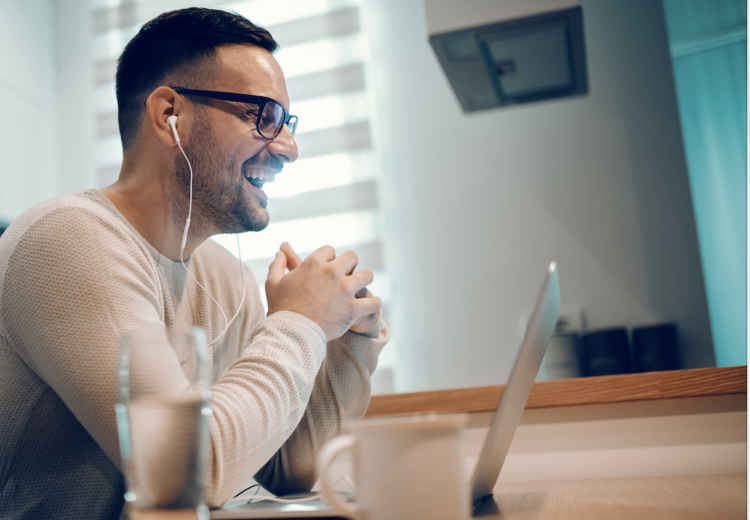How to prepare for a remote interview


Remote interviewing is here to stay, so it’s yet another thing you have to be good at. You’re doing two jobs - presenting as a candidate while performing for a camera and making sure you’re fully engaged with the people on the screen. Here are some tips that will help.
Be deliberate about your setting
Choose what’s around you on the screen carefully, because it’s sending a message to the interviewer. It may seem like it’s just a background, but it’s part of your overall presentation. Choose a space that’s neutral and doesn’t have anything that might distract your interviewer. Tidy up while your camera is on and put any clutter out of shot.
Set up the right frame
People are often too close to their webcams. It’s not normal for us to see only someone’s face and neck when we’re communicating unless we’re very close to them. Think about framing yourself so that you’ve got more than head and shoulders in shot.
Eliminate distractions
Turn off the notifications that bombard you on your computer screen (and phone) all day before the interview. You never know what might distract your attention during an important question or answer. It’s a great time to work with a single monitor - when an interviewer notices your eyes go off to a second screen, they don’t know it’s there, they just know you look distracted.
Remember to eliminate physical distractions too. Put a note on the door or wedge it shut if you have toddlers or pets!
Prepare to fake eye contact
To give the illusion of eye contact, you need to look into the camera. It sounds so simple but remember that you’re doing two jobs here, so when the pressure’s on, you’re likely to look at the actual human eyes you can see in front of you. This will always make it look like you’re not quite looking at the person. There are two things that will help you do this. First - practice. Get on a call with a colleague or a friend and practice talking directly to the camera while you’re tackling a subject that needs some thought. Secondly, put a bright sticker right next to the camera to bring your attention back to it. After a year of video meetings, that little LED indicator probably doesn’t grab your attention the way it used to. Put something new up just for the interview.
Test your tech set up
Do you even know where your microphone is? It’s amazing how many people just assume that their video and audio feeds will be studio-perfect without ever checking them. All video conference software lets you record a test clip so you can optimise your setup, so use it! Whether you can be seen and heard clearly is affected by all sorts of things from the quality of your camera to the objects sitting around your microphone. Make sure you’ve set up and tested well before the interview so you don’t turn up with tech-induced stress.
Consider earphones
Wearing earphones with an integrated microphone can be helpful in two ways. First, they will help you get over audio problems that echo-cancellation software often causes in video calls. Second, bringing the microphone closer to your mouth (and away from your keyboard) improves the reception of your voice.
Have your CV next to you
It’s the document your interviewer will be looking at, so having your CV to hand could give you an advantage. If you don’t have a printer, use a tablet - not your phone screen.
Use notes
You’ve got a unique opportunity to write prompts for yourself so you remember to sell yourself well. If a thought comes up during the interview, you can write a note to come back to it without the interviewer noticing.
Raise your camera
You should have stopped making people look up your nostrils on Zoom calls by now. Lift that laptop off the table by putting books underneath it or put it on a laptop stand.
Using a separate camera positioned in the right spot will instantly upgrade your video calls.
Get your lights right
Find a space with even lighting so your face is easy to see. Using a desk lamp can help. If you’ve got a room that’s well lit from outdoors, don’t sit with a window behind you - webcams adjusts the picture to compensate for the bright spot by making your face too dark.
Rehearse
The best way to be prepared for any question is to rehearse. It doesn’t mean you have to try giving perfectly scripted answers. Rehearsing primes you to perform better. Going through answers you know you’ll be asked will help you work out how to tell the right stories and will stop you waffling when it matters.
Warm up physically
When you arrive at a face-to-face job interview, you’ve walked and been outdoors so your blood is pumping well around your body and you’ve got your energy flowing. You’re a slightly different you to the person who has been indoors for the last week and sat in the same chair for the last four hours. Before the interview, go for a walk or at least get out of your seat and get moving to increase your energy levels. It affects the way you come across and the way you sound when presenting remotely.
Don’t let your interview be the first time you talk in the day. If you won’t be around other humans, you can warm your voice and face muscles up by reading a couple of articles to yourself.
Get dressed up
When you’re deciding what to wear, you’re usually trying to match the culture of the company. That’s tricky when you’ve become used to wearing slippers and jogging bottoms to work every day. Find your iron and get a decent work outfit together for the occasion - top and bottom halves! The way you’re dressed will affect the way you feel, therefore the way you communicate.
Interview prep
Do all the things you would normally do to prepare such as researching the company and preparing questions. Try our three-sheet interview preparation technique to make sure you’re ready for any interview.

